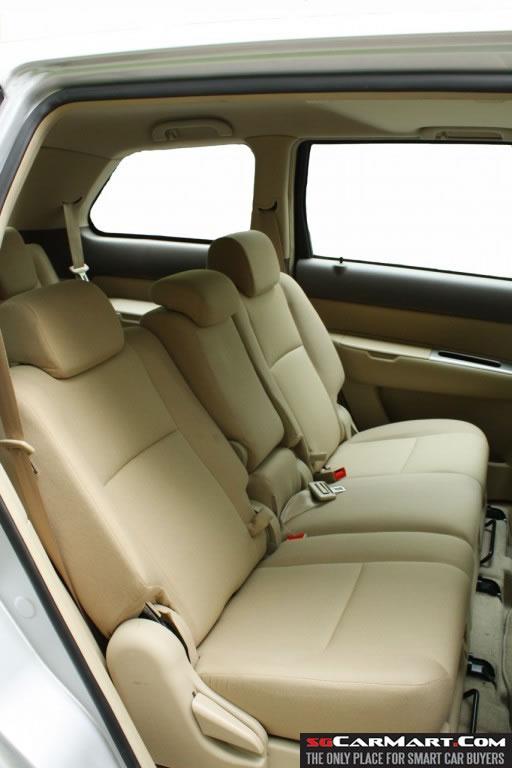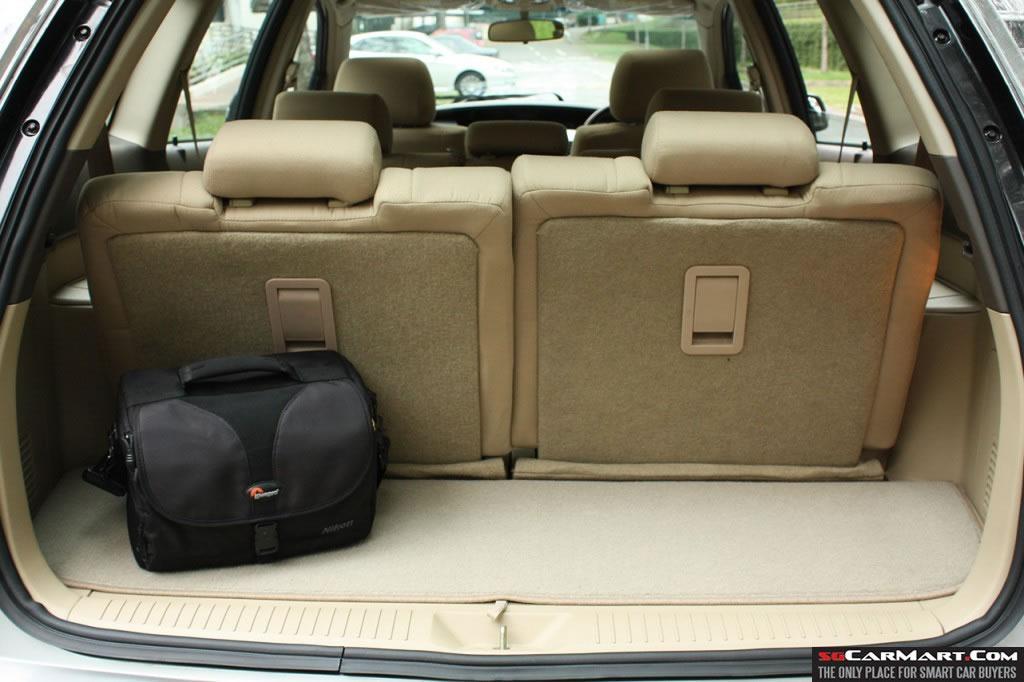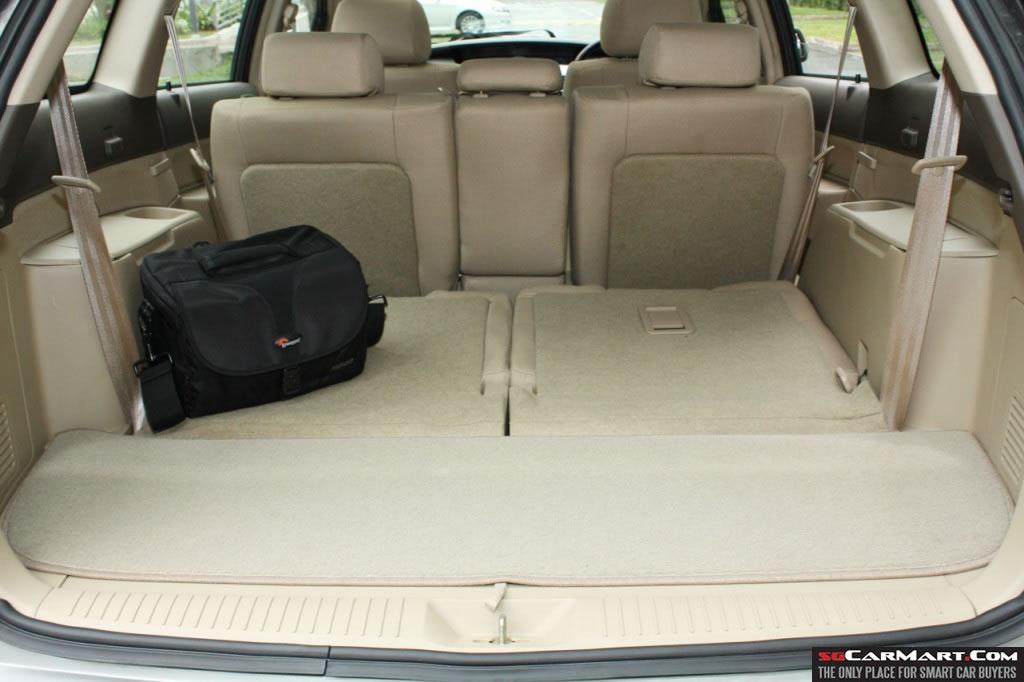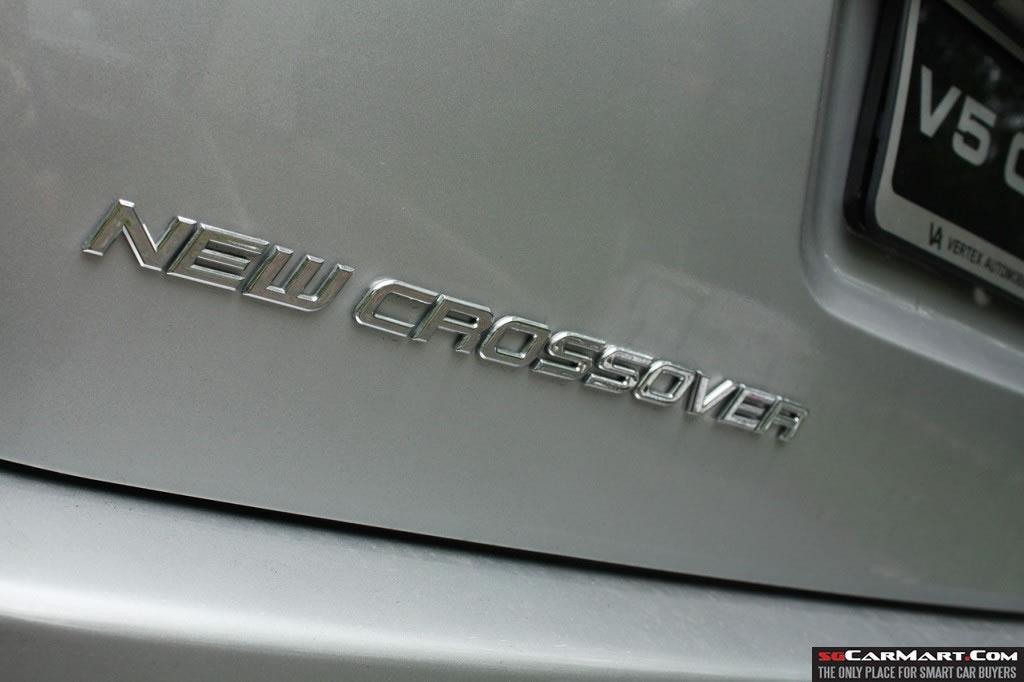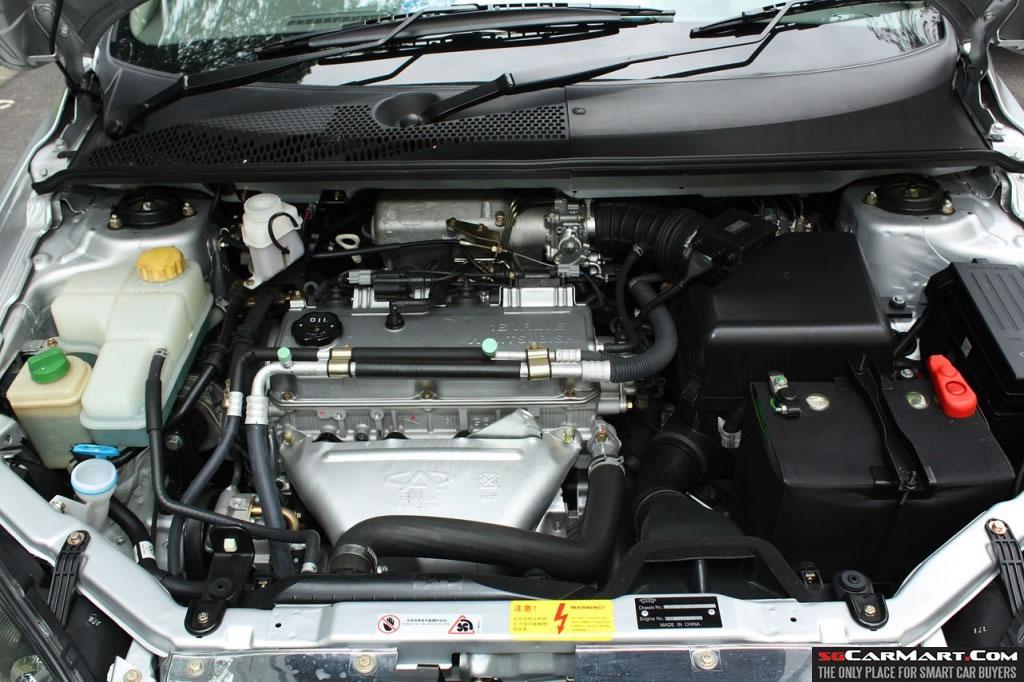Chery V5 2.4 (A) Review
25 Nov 2009|27,557 views
A China-made car is very much like a bowl of hot soup, first you have your main ingredients like™I kid! I kid! (refer to first review)
China has come a long way from the old days of communism to be the free market powerhouse that it is today. In those days, China had a desolate economy that left its people suffering and in serious risk of financial collapse. In the last 30 years since China opened up its doors to the free market enterprise, it has accelerated rapidly both in terms of economic development and technological / engineering sophistication.
Take the local aviation industry for example. In pre-1976 China, the industry could barely operate and maintain the country’s Air Force in a militarily significant posture. But 30 years later the People’s Liberation Army Air Force has become one of the most well-equipped and numerically superior aviation outfits in Asia.
An example that puts China’s engineering capability in perspective is the production of their J-11 fighter jets. This aircraft started out originally as dumbed-down export versions of the Cold War-era Su-27s from Russia.
Where Russia kept the technologically superior models for themselves, they were all too happy to sell regiments of the export models to China.
China has come a long way from the old days of communism to be the free market powerhouse that it is today. In those days, China had a desolate economy that left its people suffering and in serious risk of financial collapse. In the last 30 years since China opened up its doors to the free market enterprise, it has accelerated rapidly both in terms of economic development and technological / engineering sophistication.
Take the local aviation industry for example. In pre-1976 China, the industry could barely operate and maintain the country’s Air Force in a militarily significant posture. But 30 years later the People’s Liberation Army Air Force has become one of the most well-equipped and numerically superior aviation outfits in Asia.
An example that puts China’s engineering capability in perspective is the production of their J-11 fighter jets. This aircraft started out originally as dumbed-down export versions of the Cold War-era Su-27s from Russia.
Where Russia kept the technologically superior models for themselves, they were all too happy to sell regiments of the export models to China.
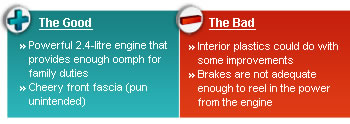 |
Now what Russia and the rest of the world (namely the U.S.) didn’t expect was that China would actually pore through every little detail of their shiny new Su-27s to reverse-engineer the aircraft from the ground up. What China came up with seven years later not only left the Russians and Western world with gaping mouths, it also gave the world a glimpse of what China’s engineers were really capable of.
The new aircraft had more than 70% of its components produced domestically. Ironing out most if not all of the aircraft’s original faults and replacing most of the aircraft’s steel surfaces with composite (carbon fibre) materials that made it much lighter and stronger.
 |
Going beyond that, they even improved on the Russian aircraft’s Achilles heel, avionics. Installing a plethora of advanced aircraft systems that were once found only in Western aircraft and equipping the cockpit with a brand new radar set and a fully digital ‘glass cockpit’. What they ended up with was a fourth generation fighter jet that far surpassed the top of the line version the Russians kept for themselves. Giving Western pilots something serious to worry about at night.
Isn’t this a car review?
Now why was all that talk about engineering and fighter jets necessary? Isn’t this a review about a car made in China? Yeah it is. Besides my obvious fascination with fighter jets, the introduction was a good example of why cars from China can only get better with time.
Given the widely demonstrated engineering expertise available in the Chinese industry, it’s only a matter of time before we see it trickle down to the local auto industry. We will start to see the same quality standards we’re so accustomed to seeing in Japanese and Continental cars in a decade (maybe half) or so.
Design
The first thing you notice about the V5 is the subtle hint of ‘Hyundaism’ in the front fascia. That black grille and individual quad headlight setup seems a little familiar but you can’t quite put your finger on it. Then it hits you! It has an identical front fascia to the Comfort Hyundai Sonata cab you flagged this morning. It does give the Chinese MPV a rather friendly face though.
From the friendly face originates a sloping A-pillar that swoops gently down the rest of the car towards the rear quarters. Making a nice and almost slippery looking side-profile. The blacked out B and C pillars distinguishes cabin area.
Isn’t this a car review?
Now why was all that talk about engineering and fighter jets necessary? Isn’t this a review about a car made in China? Yeah it is. Besides my obvious fascination with fighter jets, the introduction was a good example of why cars from China can only get better with time.
Given the widely demonstrated engineering expertise available in the Chinese industry, it’s only a matter of time before we see it trickle down to the local auto industry. We will start to see the same quality standards we’re so accustomed to seeing in Japanese and Continental cars in a decade (maybe half) or so.
Design
The first thing you notice about the V5 is the subtle hint of ‘Hyundaism’ in the front fascia. That black grille and individual quad headlight setup seems a little familiar but you can’t quite put your finger on it. Then it hits you! It has an identical front fascia to the Comfort Hyundai Sonata cab you flagged this morning. It does give the Chinese MPV a rather friendly face though.
From the friendly face originates a sloping A-pillar that swoops gently down the rest of the car towards the rear quarters. Making a nice and almost slippery looking side-profile. The blacked out B and C pillars distinguishes cabin area.
The D pillars in the rear are adorned with a pair of crystal taillights set high up. A large tailgate sums up the rear.
Interior
Getting into the V5, you adjust the rake adjustable steering wheel to get in the best position. After which you realise the instrument panel which normally should be placed in front of the driver, is placed in the centre. Although in full view of all passengers, the information displayed isn’t necessary for anyone besides the driver. It irks me that the instrument panel isn’t where it belongs.
Besides that, the driving position is actually quite comfortable with both front seats equipped with airbags. You’re seating low in the cabin almost like a Toyota Wish. Controls for the automatic transmission, stereo and aircon are all well within the driver’s reach. Score one for ergonomics then. Steering mounted audio controls are another plus point.
The overall beige interior makes the cabin a pleasant place to be in. But the interior plastics could do with some work. During the test, the centre console refused to be closed. The low budget polished wood trim seem outdated here. Style conscious consumers will either prefer to change it out or it might scare them off the V5 completely.
Opening the solid doors reveals the second row of seats in the V5 which sits three passengers comfortably although the centre passenger might feel a little cramped. Even though the third row of seats fold down flat to avail additional boot space, the second row does not, which might affect the V5’s popularity when compared to other MPVs in this price segment.
The bootlid was heavier than we expected it to be and isn’t heavily assisted by the hydraulics, so some muscle tensioning on your part is required.
Interior
Getting into the V5, you adjust the rake adjustable steering wheel to get in the best position. After which you realise the instrument panel which normally should be placed in front of the driver, is placed in the centre. Although in full view of all passengers, the information displayed isn’t necessary for anyone besides the driver. It irks me that the instrument panel isn’t where it belongs.
Besides that, the driving position is actually quite comfortable with both front seats equipped with airbags. You’re seating low in the cabin almost like a Toyota Wish. Controls for the automatic transmission, stereo and aircon are all well within the driver’s reach. Score one for ergonomics then. Steering mounted audio controls are another plus point.
The overall beige interior makes the cabin a pleasant place to be in. But the interior plastics could do with some work. During the test, the centre console refused to be closed. The low budget polished wood trim seem outdated here. Style conscious consumers will either prefer to change it out or it might scare them off the V5 completely.
Opening the solid doors reveals the second row of seats in the V5 which sits three passengers comfortably although the centre passenger might feel a little cramped. Even though the third row of seats fold down flat to avail additional boot space, the second row does not, which might affect the V5’s popularity when compared to other MPVs in this price segment.
The bootlid was heavier than we expected it to be and isn’t heavily assisted by the hydraulics, so some muscle tensioning on your part is required.
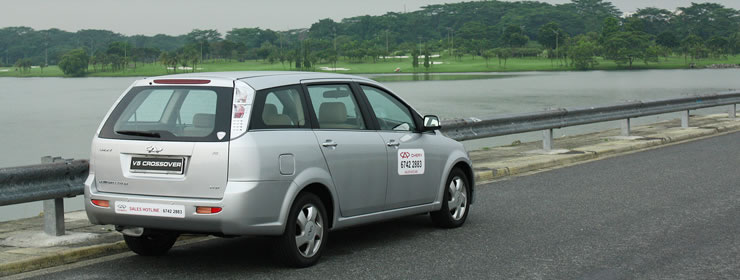 |
Driving Impressions
Equipped with a Mitsubishi 4G64 2.4-litre unit, the car gets off the line well. Providing enough low-end grunt to get the car’s 1.5 tons under way towards a 100 km/h in 15 seconds. While giving the confidence that it’ll pull along more than its own weight. Despite having such a powerhouse unit under the bonnet, Chery failed to foresee the need for a capable braking system.
The brakes on the V5 seemed overwhelmed by the task of reeling in the 1.5 tons, and required a monumental amount of heavy footed braking to stop. This might be an even greater problem when taking a full load of seven passengers and cargo onboard.
On the roads, the car’s side mirrors prove to be inadequate for the car’s bulk, forcing you to turn back often for a physical eyeball check. The mirrors would be perfect on a Mini but are out of place on a blind-spot ridden MPV. Best advice is to get them changed for bigger ones the moment you’re off the showroom floor.
Equipped with a Mitsubishi 4G64 2.4-litre unit, the car gets off the line well. Providing enough low-end grunt to get the car’s 1.5 tons under way towards a 100 km/h in 15 seconds. While giving the confidence that it’ll pull along more than its own weight. Despite having such a powerhouse unit under the bonnet, Chery failed to foresee the need for a capable braking system.
The brakes on the V5 seemed overwhelmed by the task of reeling in the 1.5 tons, and required a monumental amount of heavy footed braking to stop. This might be an even greater problem when taking a full load of seven passengers and cargo onboard.
On the roads, the car’s side mirrors prove to be inadequate for the car’s bulk, forcing you to turn back often for a physical eyeball check. The mirrors would be perfect on a Mini but are out of place on a blind-spot ridden MPV. Best advice is to get them changed for bigger ones the moment you’re off the showroom floor.
The ride in the V5 is comfortable with most road undulations diverted away from your bum through its Macpherson and Multi-link suspension. Although the suspension does firm up a bit with added bulk in the car. On the highway the MPV cruises with ease and makes overtaking a breeze with its 4-cylinder in-line unit revved up.
Conclusion
The Chery V5 is worthy of being marketed as an affordable MPV. At the price of $66,999, it will appeal to drivers who dislike the high centre of gravity in the Suzuki APV and the feeble 1.6-litre unit of the Proton Exora. It provides adequate power to haul your entire family while still keeping them relatively safe. From the looks of it, it might be a serious option for would-be Exora owners.
Conclusion
The Chery V5 is worthy of being marketed as an affordable MPV. At the price of $66,999, it will appeal to drivers who dislike the high centre of gravity in the Suzuki APV and the feeble 1.6-litre unit of the Proton Exora. It provides adequate power to haul your entire family while still keeping them relatively safe. From the looks of it, it might be a serious option for would-be Exora owners.
A China-made car is very much like a bowl of hot soup, first you have your main ingredients like™I kid! I kid! (refer to first review)
China has come a long way from the old days of communism to be the free market powerhouse that it is today. In those days, China had a desolate economy that left its people suffering and in serious risk of financial collapse. In the last 30 years since China opened up its doors to the free market enterprise, it has accelerated rapidly both in terms of economic development and technological / engineering sophistication.
Take the local aviation industry for example. In pre-1976 China, the industry could barely operate and maintain the country’s Air Force in a militarily significant posture. But 30 years later the People’s Liberation Army Air Force has become one of the most well-equipped and numerically superior aviation outfits in Asia.
An example that puts China’s engineering capability in perspective is the production of their J-11 fighter jets. This aircraft started out originally as dumbed-down export versions of the Cold War-era Su-27s from Russia.
Where Russia kept the technologically superior models for themselves, they were all too happy to sell regiments of the export models to China.
China has come a long way from the old days of communism to be the free market powerhouse that it is today. In those days, China had a desolate economy that left its people suffering and in serious risk of financial collapse. In the last 30 years since China opened up its doors to the free market enterprise, it has accelerated rapidly both in terms of economic development and technological / engineering sophistication.
Take the local aviation industry for example. In pre-1976 China, the industry could barely operate and maintain the country’s Air Force in a militarily significant posture. But 30 years later the People’s Liberation Army Air Force has become one of the most well-equipped and numerically superior aviation outfits in Asia.
An example that puts China’s engineering capability in perspective is the production of their J-11 fighter jets. This aircraft started out originally as dumbed-down export versions of the Cold War-era Su-27s from Russia.
Where Russia kept the technologically superior models for themselves, they were all too happy to sell regiments of the export models to China.
 |
Now what Russia and the rest of the world (namely the U.S.) didn’t expect was that China would actually pore through every little detail of their shiny new Su-27s to reverse-engineer the aircraft from the ground up. What China came up with seven years later not only left the Russians and Western world with gaping mouths, it also gave the world a glimpse of what China’s engineers were really capable of.
The new aircraft had more than 70% of its components produced domestically. Ironing out most if not all of the aircraft’s original faults and replacing most of the aircraft’s steel surfaces with composite (carbon fibre) materials that made it much lighter and stronger.
 |
Going beyond that, they even improved on the Russian aircraft’s Achilles heel, avionics. Installing a plethora of advanced aircraft systems that were once found only in Western aircraft and equipping the cockpit with a brand new radar set and a fully digital ‘glass cockpit’. What they ended up with was a fourth generation fighter jet that far surpassed the top of the line version the Russians kept for themselves. Giving Western pilots something serious to worry about at night.
Isn’t this a car review?
Now why was all that talk about engineering and fighter jets necessary? Isn’t this a review about a car made in China? Yeah it is. Besides my obvious fascination with fighter jets, the introduction was a good example of why cars from China can only get better with time.
Given the widely demonstrated engineering expertise available in the Chinese industry, it’s only a matter of time before we see it trickle down to the local auto industry. We will start to see the same quality standards we’re so accustomed to seeing in Japanese and Continental cars in a decade (maybe half) or so.
Design
The first thing you notice about the V5 is the subtle hint of ‘Hyundaism’ in the front fascia. That black grille and individual quad headlight setup seems a little familiar but you can’t quite put your finger on it. Then it hits you! It has an identical front fascia to the Comfort Hyundai Sonata cab you flagged this morning. It does give the Chinese MPV a rather friendly face though.
From the friendly face originates a sloping A-pillar that swoops gently down the rest of the car towards the rear quarters. Making a nice and almost slippery looking side-profile. The blacked out B and C pillars distinguishes cabin area.
Isn’t this a car review?
Now why was all that talk about engineering and fighter jets necessary? Isn’t this a review about a car made in China? Yeah it is. Besides my obvious fascination with fighter jets, the introduction was a good example of why cars from China can only get better with time.
Given the widely demonstrated engineering expertise available in the Chinese industry, it’s only a matter of time before we see it trickle down to the local auto industry. We will start to see the same quality standards we’re so accustomed to seeing in Japanese and Continental cars in a decade (maybe half) or so.
Design
The first thing you notice about the V5 is the subtle hint of ‘Hyundaism’ in the front fascia. That black grille and individual quad headlight setup seems a little familiar but you can’t quite put your finger on it. Then it hits you! It has an identical front fascia to the Comfort Hyundai Sonata cab you flagged this morning. It does give the Chinese MPV a rather friendly face though.
From the friendly face originates a sloping A-pillar that swoops gently down the rest of the car towards the rear quarters. Making a nice and almost slippery looking side-profile. The blacked out B and C pillars distinguishes cabin area.
The D pillars in the rear are adorned with a pair of crystal taillights set high up. A large tailgate sums up the rear.
Interior
Getting into the V5, you adjust the rake adjustable steering wheel to get in the best position. After which you realise the instrument panel which normally should be placed in front of the driver, is placed in the centre. Although in full view of all passengers, the information displayed isn’t necessary for anyone besides the driver. It irks me that the instrument panel isn’t where it belongs.
Besides that, the driving position is actually quite comfortable with both front seats equipped with airbags. You’re seating low in the cabin almost like a Toyota Wish. Controls for the automatic transmission, stereo and aircon are all well within the driver’s reach. Score one for ergonomics then. Steering mounted audio controls are another plus point.
The overall beige interior makes the cabin a pleasant place to be in. But the interior plastics could do with some work. During the test, the centre console refused to be closed. The low budget polished wood trim seem outdated here. Style conscious consumers will either prefer to change it out or it might scare them off the V5 completely.
Opening the solid doors reveals the second row of seats in the V5 which sits three passengers comfortably although the centre passenger might feel a little cramped. Even though the third row of seats fold down flat to avail additional boot space, the second row does not, which might affect the V5’s popularity when compared to other MPVs in this price segment.
The bootlid was heavier than we expected it to be and isn’t heavily assisted by the hydraulics, so some muscle tensioning on your part is required.
Interior
Getting into the V5, you adjust the rake adjustable steering wheel to get in the best position. After which you realise the instrument panel which normally should be placed in front of the driver, is placed in the centre. Although in full view of all passengers, the information displayed isn’t necessary for anyone besides the driver. It irks me that the instrument panel isn’t where it belongs.
Besides that, the driving position is actually quite comfortable with both front seats equipped with airbags. You’re seating low in the cabin almost like a Toyota Wish. Controls for the automatic transmission, stereo and aircon are all well within the driver’s reach. Score one for ergonomics then. Steering mounted audio controls are another plus point.
The overall beige interior makes the cabin a pleasant place to be in. But the interior plastics could do with some work. During the test, the centre console refused to be closed. The low budget polished wood trim seem outdated here. Style conscious consumers will either prefer to change it out or it might scare them off the V5 completely.
Opening the solid doors reveals the second row of seats in the V5 which sits three passengers comfortably although the centre passenger might feel a little cramped. Even though the third row of seats fold down flat to avail additional boot space, the second row does not, which might affect the V5’s popularity when compared to other MPVs in this price segment.
The bootlid was heavier than we expected it to be and isn’t heavily assisted by the hydraulics, so some muscle tensioning on your part is required.
 |
Driving Impressions
Equipped with a Mitsubishi 4G64 2.4-litre unit, the car gets off the line well. Providing enough low-end grunt to get the car’s 1.5 tons under way towards a 100 km/h in 15 seconds. While giving the confidence that it’ll pull along more than its own weight. Despite having such a powerhouse unit under the bonnet, Chery failed to foresee the need for a capable braking system.
The brakes on the V5 seemed overwhelmed by the task of reeling in the 1.5 tons, and required a monumental amount of heavy footed braking to stop. This might be an even greater problem when taking a full load of seven passengers and cargo onboard.
On the roads, the car’s side mirrors prove to be inadequate for the car’s bulk, forcing you to turn back often for a physical eyeball check. The mirrors would be perfect on a Mini but are out of place on a blind-spot ridden MPV. Best advice is to get them changed for bigger ones the moment you’re off the showroom floor.
Equipped with a Mitsubishi 4G64 2.4-litre unit, the car gets off the line well. Providing enough low-end grunt to get the car’s 1.5 tons under way towards a 100 km/h in 15 seconds. While giving the confidence that it’ll pull along more than its own weight. Despite having such a powerhouse unit under the bonnet, Chery failed to foresee the need for a capable braking system.
The brakes on the V5 seemed overwhelmed by the task of reeling in the 1.5 tons, and required a monumental amount of heavy footed braking to stop. This might be an even greater problem when taking a full load of seven passengers and cargo onboard.
On the roads, the car’s side mirrors prove to be inadequate for the car’s bulk, forcing you to turn back often for a physical eyeball check. The mirrors would be perfect on a Mini but are out of place on a blind-spot ridden MPV. Best advice is to get them changed for bigger ones the moment you’re off the showroom floor.
The ride in the V5 is comfortable with most road undulations diverted away from your bum through its Macpherson and Multi-link suspension. Although the suspension does firm up a bit with added bulk in the car. On the highway the MPV cruises with ease and makes overtaking a breeze with its 4-cylinder in-line unit revved up.
Conclusion
The Chery V5 is worthy of being marketed as an affordable MPV. At the price of $66,999, it will appeal to drivers who dislike the high centre of gravity in the Suzuki APV and the feeble 1.6-litre unit of the Proton Exora. It provides adequate power to haul your entire family while still keeping them relatively safe. From the looks of it, it might be a serious option for would-be Exora owners.
Conclusion
The Chery V5 is worthy of being marketed as an affordable MPV. At the price of $66,999, it will appeal to drivers who dislike the high centre of gravity in the Suzuki APV and the feeble 1.6-litre unit of the Proton Exora. It provides adequate power to haul your entire family while still keeping them relatively safe. From the looks of it, it might be a serious option for would-be Exora owners.
Car Information
Chery V5 2.4 (A)
CAT B|Petrol|11.3km/L
Horsepower
97kW (130 bhp)
Torque
198 Nm
Acceleration
15sec (0-100km /hr)
This model is no longer being sold by local distributor
All Used Chery V5Thank You For Your Subscription.














